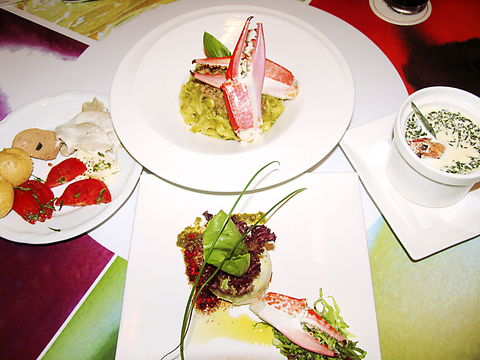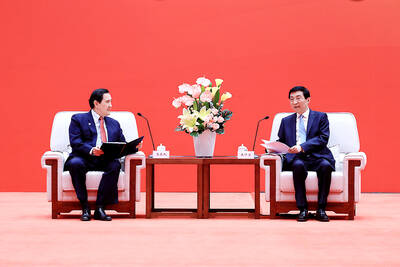Gourmet diners always look forward to this time of year because it means crabs are back on the menu. Having fattened up over the summer months in preparation for the winter ahead they are at their best now.
At many restaurants here around this time there is a fever for the Chinese Yangcheng Lake hairy crab, which is relatively small and expensive. But, like many other items from China, it is just as likely to be a fake even though it has a ring or even a laser stamp supposedly guaranteeing its authenticity. So, a better bet is to check out the Grand Formosa Regent's restaurants, where you can sample crabs from around the world.
The "intercontinental crab feast" has been put together by the new food and beverage manager at the hotel, Claudio Melli, who had the bright idea of inviting chefs from Japan, France, Italy, Switzerland, Singapore, and Guangzhou and Shanghai in China, to prepare their favorite 10-legged crustacean for the table.

PHOTO: JULES QUARTLY, TAIPEI TIMES
The steamed Okhotsk Sea crab with Japanese roasted rice tea is probably the star arthropod and is one of the largest crabs you can find that is good to eat, since it comes from the icy clean waters between Russia and Japan. It is served up at the hotel's Wasabi dining bar and has a five-star price of NT$4,500. Also, you must order your crab two days in advance (see details above).
Other dining options include the Shanghai steamed rose crab with spring onion at the Lan Ting restaurant (the most popular choice, according to a hotel representative, because of its creamy eggs); the Cantonese buttered virgin mud crab at the Formosa Club; the Chilean spider crab served up in a French style at Robin's Grill; and the heavyweight Sri Lanka crab with Singaporean chili (two days notice required) at the "azie"
restaurant.
We were offered the four-course menu at Cafe Studio which started with an excellent crabmeat and goat cheese terrine with drizzled green and red pepper corn oil, followed by crabmeat and prawn soup with basil and bay leaf. The fetuccine with crabmeat and porcini mushrooms main dish was sound, while the sauteed watermelon and orange sauce with vanilla ice cream was a great ending to the meal, the heat of the sauce and tang of orange setting off the ice cream perfectly.

The canonical shot of an East Asian city is a night skyline studded with towering apartment and office buildings, bright with neon and plastic signage, a landscape of energy and modernity. Another classic image is the same city seen from above, in which identical apartment towers march across the city, spilling out over nearby geography, like stylized soldiers colonizing new territory in a board game. Densely populated dynamic conurbations of money, technological innovation and convenience, it is hard to see the cities of East Asia as what they truly are: necropolises. Why is this? The East Asian development model, with

Desperate dads meet in car parks to exchange packets; exhausted parents slip it into their kids’ drinks; families wait months for prescriptions buy it “off label.” But is it worth the risk? “The first time I gave him a gummy, I thought, ‘Oh my God, have I killed him?’ He just passed out in front of the TV. That never happens.” Jen remembers giving her son, David, six, melatonin to help him sleep. She got them from a friend, a pediatrician who gave them to her own child. “It was sort of hilarious. She had half a tub of gummies,

The wide-screen spectacle of Formula One gets a gleaming, rip-roaring workout in Joseph Kosinski’s F1, a fine-tuned machine of a movie that, in its most riveting racing scenes, approaches a kind of high-speed splendor. Kosinski, who last endeavored to put moviegoers in the seat of a fighter jet in Top Gun: Maverick, has moved to the open cockpits of Formula One with much the same affection, if not outright need, for speed. A lot of the same team is back. Jerry Bruckheimer produces. Ehren Kruger, a co-writer on Maverick, takes sole credit here. Hans Zimmer, a co-composer previously, supplies the thumping

There is an old British curse, “may you live in interesting times,” passed off as ancient Chinese wisdom to make it sound more exotic and profound. We are living in interesting times. From US President Donald Trump’s decision on American tariffs, to how the recalls will play out, to uncertainty about how events are evolving in China, we can do nothing more than wait with bated breath. At the cusp of potentially momentous change, it is a good time to take stock of the current state of Taiwan’s political parties. As things stand, all three major parties are struggling. For our examination of the